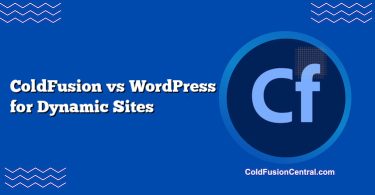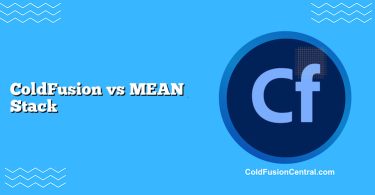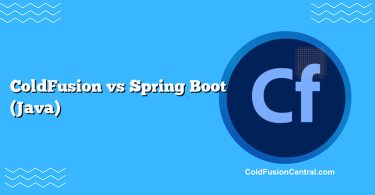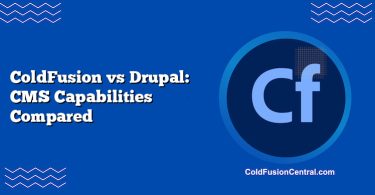Definitions
-
ColdFusion: A rapid application development platform originally created by Allaire and now offered as Adobe ColdFusion (commercial) and Lucee (open-source). It uses CFML (ColdFusion Markup Language), a tag- and script-based language running on the JVM, and provides many batteries-included features such as PDF generation, scheduling, and mail services.
-
Laravel: A modern open-source PHP MVC framework focused on developer experience and clean architecture. It provides expressive routing, Eloquent ORM, Blade templating, a robust CLI (Artisan), queues, caching, and first-class tooling for API and web application development.
Overview
ColdFusion and Laravel solve similar problems—building web apps and APIs—but come from different eras and ecosystems. ColdFusion emphasizes productivity with server features built into the platform, while Laravel emphasizes elegance, convention-over-configuration, and the leverage of the broader PHP ecosystem.
- ColdFusion (Adobe or Lucee) runs on the JVM, supports CFML syntax, and shines when you want rapid delivery of enterprise features with minimal external dependencies.
- Laravel runs on PHP 8+, embraces modern best practices (dependency injection, service container, testing), and has a massive package ecosystem and community.
Key Features
ColdFusion (Adobe ColdFusion and Lucee)
- Built-in services: PDF generation, schedulers, mail, image manipulation, spreadsheet I/O, caching.
- CFML (tags and script) for quick development; integrates easily with Java libraries.
- ORM support (Hibernate in Adobe CF), REST endpoints, WebSocket channels.
- Enterprise capabilities: session clustering, admin console, lockdown installers, performance monitoring.
- Commercial support (Adobe); community-driven alternative (Lucee) for open-source deployments.
Laravel (PHP Framework)
- Expressive routing and controllers; Blade templating.
- Eloquent ORM with fluent relationships and query builder.
- Robust CLI (Artisan) for scaffolding, migrations, seeding, tests.
- First-class features: queues (Redis, SQS), caching, events, broadcasting, jobs.
- Official ecosystem: Forge (server management), Vapor (serverless on AWS), Nova (admin panels), Sail (Docker).
- Testability and maintainability with built-in PHPUnit/Pest support, policies/gates, and middleware.
Performance
- ColdFusion: Runs on the JVM, benefiting from JIT compilation and mature garbage collection. Performance can be strong for CPU-bound tasks and complex enterprise workflows, especially when leveraging caching and asynchronous features. Adobe CF’s performance monitor and FusionReactor can help identify bottlenecks.
- Laravel: Runs on PHP 8+ with Opcache and optional JIT. Typical deployments use PHP-FPM with Nginx/Apache. For higher throughput and lower latency, teams adopt Swoole, OpenSwoole, or RoadRunner to avoid per-request bootstrap overhead. Proper caching (Redis), queue offloading, and optimizing autoload/compiled containers narrow performance gaps.
Practical note: For most CRUD apps and REST APIs, both can hit acceptable latency and throughput with good architecture and caching. At very high scale or low-latency needs, Laravel with Swoole/RoadRunner or ColdFusion with tuned JVM settings and horizontal scaling can both succeed.
Scalability
- ColdFusion:
- Vertical: JVM tuning, multi-threading, connection pools.
- Horizontal: Clustering, session replication, sticky sessions, external session stores, CDN.
- Integrations: Can call Java services, use message brokers, and run behind load balancers.
- Laravel:
- Horizontal by default: Stateless HTTP layer, external sessions/cache (Redis), and queues (SQS, RabbitMQ, Redis).
- Serverless: Laravel Vapor (AWS Lambda) enables near-infinite burst scaling, especially for APIs and event-driven workloads.
- Microservices: Commonly used with containers and service meshes; easy to split domains via Composer packages and queues.
If your plan involves serverless or microservices-heavy architectures, Laravel’s ecosystem has more ready-made patterns. For monolithic enterprise apps, ColdFusion clustering remains straightforward.
Security
- ColdFusion:
- Adobe CF provides lockdown installers, secure profile configurations, built-in sanitization, and integration with enterprise identity providers.
- History includes notable CVEs; patch cadence and disciplined ops are crucial. Centralized admin and monitoring tools aid governance.
- Laravel:
- Framework-level protections: CSRF tokens, XSS escaping via Blade, prepared statements for SQL, encrypted cookies, password hashing (Argon2/Bcrypt), validation.
- Regular security releases and robust community scrutiny; security advisories via GitHub and Composer tooling.
Both are secure when configured and maintained correctly. Laravel’s defaults are very safe out-of-the-box; ColdFusion’s enterprise controls can be excellent with proper hardening and timely updates.
Cost
- ColdFusion:
- Adobe ColdFusion requires licensing (Standard/Enterprise). Costs can be significant but may be justified by reduced development time and enterprise features/support.
- Lucee is open-source and free, lowering runtime costs but potentially increasing DIY responsibilities.
- Laravel:
- Open-source and free. Costs center on hosting, managed services (e.g., Forge, Vapor), and developer time.
- Large hiring pool often reduces personnel cost and risk.
For budget-sensitive or startup scenarios, Laravel usually wins. For enterprises prioritizing vendor-backed support and integrated features, Adobe ColdFusion’s licensing can be acceptable.
Community Support
- ColdFusion:
- Smaller but loyal community. Adobe offers enterprise support; Lucee has an active OSS community.
- Fewer third-party packages than PHP’s Composer ecosystem.
- Laravel:
- Massive global community; abundant tutorials, conferences, podcasts, and courses.
- Huge Composer ecosystem; fast-moving innovation and best practices.
If access to packages, tutorials, and hiring pipelines is a priority, Laravel’s community is a major advantage.
Development Experience and Syntax
- CFML (ColdFusion):
- Tag-based and script-based syntax; easy to read for HTML-centric developers.
- Rapid prototyping with built-in tags (cfquery, cfmail, cfhttp, cfdocument).
- Can integrate Java libraries; ORM (Hibernate) in Adobe CF.
- PHP/Laravel:
- PHP 8+ with strict typing, attributes, enums; PSR standards and Composer autoloading.
- Elegant patterns (Service Container, Repository, Events), Blade for views, Eloquent for ORM.
- Strong testing culture, code quality tools (PHPStan, Psalm), and CI/CD patterns.
Example syntax difference (simple query and output):
-
CFML (script style):
- cfset result = queryExecute(“SELECT name FROM users WHERE id = :id”, {id=1})
- writeOutput(result.name)
-
Laravel (controller method):
- $user = User::find(1);
- return view(‘profile’, [‘name’ => $user->name]);
Ecosystem and Tooling
- ColdFusion:
- Adobe ColdFusion Administrator, ColdFusion Builder, and monitoring via Performance Monitoring Toolset or FusionReactor.
- CommandBox for package management and CLI workflows (especially in Lucee/modern CFML ecosystems).
- Laravel:
- Artisan CLI, Composer, Laravel Sail (Docker), Homestead (Vagrant), Forge (server management), Vapor (serverless), Nova (admin), Envoy (task runner).
- Rich CI/CD support and DevOps integrations.
Tooling maturity and breadth strongly favor Laravel, particularly for modern delivery pipelines and cloud-native operations.
Use Cases and Real-World Scenarios
- When to prefer ColdFusion:
- A mid-size enterprise has an existing CFML codebase handling document generation, scheduled jobs, and intranet workflows. The team needs to expand features quickly and relies on PDF/Excel generation and centralized admin. ColdFusion’s built-in services and JVM integration streamline delivery without assembling many external services.
- When to prefer Laravel:
- A SaaS startup is building a multi-tenant REST API with public-facing dashboards. They need rapid iteration, cost-effective scaling, and modern tooling for CI/CD. Laravel’s ecosystem (Horizon for queues, Telescope for debugging, Passport/Sanctum for auth) and the PHP talent pool reduce time-to-market and hiring risk. Serverless via Vapor enables cost-effective bursts.
Step-by-step insight for delivery:
- Prototype: ColdFusion’s tags or Laravel’s Artisan make scaffolding fast.
- Data Layer: ColdFusion ORM/Hibernate vs Laravel Eloquent + migrations.
- Security: Configure CF lockdown/hardening or rely on Laravel’s defaults plus security headers.
- Scale: ColdFusion clustering and JVM tuning vs Laravel horizontal scale with Redis queues and CDN.
- Observability: FusionReactor/PMT vs Laravel Telescope, OpenTelemetry, and APMs (Datadog, New Relic).
Side-by-Side Comparison Table
| Aspect | ColdFusion (Adobe/Lucee) | Laravel (PHP) |
|---|---|---|
| Runtime | JVM (CFML) | PHP 8+ (PHP-FPM, Swoole/RoadRunner optional) |
| Paradigm | Batteries-included RAD | MVC with rich ecosystem |
| Performance | Strong with JVM tuning, caching | Strong with Opcache; excellent with Swoole/RoadRunner |
| Scalability | Clustering, session replication | Stateless horizontal scaling; serverless via Vapor |
| Security | Enterprise hardening; patch discipline needed | Secure defaults: CSRF, XSS, SQLi protections |
| Cost | Adobe licenses (or free via Lucee) | Open-source; pay for hosting/services |
| Community | Smaller, vendor-backed | Very large, active, fast-moving |
| Use Cases | Enterprise workflows, PDFs, intranets | SaaS, APIs, microservices, public sites |
| Pros | Built-in features, JVM power, admin console | Ecosystem, talent pool, tooling, patterns |
| Cons | Licensing (Adobe), smaller ecosystem | Must assemble features; choices can be overwhelming |
Pros and Cons
ColdFusion Pros
- Built-in services reduce integration work (PDF, mail, schedulers, image, spreadsheet).
- JVM performance characteristics and access to Java libraries.
- Adobe enterprise support; Lucee offers a free, open-source path.
- Centralized administration and monitoring options.
ColdFusion Cons
- Adobe licensing costs; smaller hiring pool and ecosystem.
- Fewer community packages and tutorials.
- Historical security CVEs require strict patch management.
- Some cloud-native patterns require more manual setup.
Laravel Pros
- Massive ecosystem (Composer packages), excellent documentation, and community support.
- Expressive codebase with Eloquent, Blade, and Service Container promoting maintainability.
- Modern DevOps and cloud-native tooling (Forge, Vapor) enable rapid scaling and delivery.
- Strong defaults for security and testing.
Laravel Cons
- You may assemble multiple services (queues, cache, PDF engines), increasing moving parts.
- Performance tuning (beyond PHP-FPM) may require Swoole/RoadRunner or serverless paradigms.
- Rapid ecosystem evolution demands ongoing upkeep.
- Architectural freedom can lead to inconsistency without strong team conventions.
Decision Factors / Which One Should You Choose?
-
Team Skills and Hiring:
- Choose Laravel if you need a large hiring pool and modern PHP practices.
- Choose ColdFusion if your team already excels at CFML or you maintain a sizable CF legacy.
-
Budget and Licensing:
- Laravel is generally more cost-effective; open-source with predictable hosting costs.
- Adobe ColdFusion licensing can be justified for enterprises valuing vendor-backed features/support; Lucee can reduce runtime costs.
-
Feature Integration vs Ecosystem:
- ColdFusion shines when you want built-ins like PDF, scheduler, email without external tooling.
- Laravel wins if you prefer best-of-breed components and rich package options.
-
Architecture and Scale:
- Laravel has the edge for microservices, serverless, and modern CI/CD pipelines.
- ColdFusion is strong for monoliths with enterprise features and JVM-based scaling.
-
Long-Term Maintainability:
- Laravel’s conventions, tests, and tooling support sustained code quality at scale.
- ColdFusion can be maintainable, but consider ecosystem size and future hiring needs.
If you’re starting greenfield with a focus on APIs, scaling, and developer availability, pick Laravel. If you’re in an enterprise environment with existing CFML expertise and heavy use of built-in features, ColdFusion remains a strong option.
Supported Platforms and Deployment Options
-
ColdFusion:
- OS: Windows, Linux, macOS (primarily for development).
- App Servers: Built-in Tomcat; integrates with IIS/Apache.
- Cloud: Works on major clouds; containerization with Docker images available; clustering supported.
-
Laravel:
- OS: Linux (most common), Windows, macOS for development.
- Web Servers: Nginx/Apache; PHP-FPM common; Swoole/RoadRunner for async.
- Cloud: Widely supported on AWS/GCP/Azure; Laravel Forge for servers; Vapor for AWS Lambda.
Key Takeaways
- ColdFusion provides a batteries-included, enterprise-friendly platform with CFML on the JVM. It’s ideal for rapid delivery of features like PDF generation, scheduling, and administrative control, especially in organizations with existing CF investment.
- Laravel offers a modern PHP framework with immense community support, a thriving ecosystem, and first-class tooling. It’s well-suited for greenfield development, REST APIs, microservices, and cloud-native strategies.
- Cost, team skills, architectural goals, and long-term maintainability are the main deciding factors. For most new projects with budget constraints and hiring considerations, Laravel is the default choice. For established enterprises or feature-rich monoliths leveraging JVM strengths and built-in services, ColdFusion can be a pragmatic path—particularly with Lucee to mitigate licensing.
FAQ
Is ColdFusion still used in production?
Yes. Many enterprises maintain mission-critical ColdFusion applications, especially in government, finance, logistics, and publishing. Adobe continues to release new versions, and the Lucee project provides an open-source engine for CFML deployments.
Can Laravel match ColdFusion’s built-in features like PDF generation?
Laravel can match most features through packages and services. For example, PDF generation can be handled by wkhtmltopdf-based libraries or headless Chrome. While not “built-in,” the PHP ecosystem offers reliable, well-maintained options.
Which scales better for high-traffic APIs?
Both can scale effectively with proper architecture. Laravel has an advantage with serverless (Vapor) and asynchronous servers (Swoole/RoadRunner), while ColdFusion leverages JVM tuning and clustering. Your team’s expertise and environment often determine which will scale more smoothly.
How hard is it to migrate from ColdFusion to Laravel?
It depends on the codebase size and CFML-specific features in use. Typical steps include domain modeling in Eloquent, re-implementing scheduled tasks in queues/cron, replacing CFML tags with Laravel services/packages, and building a migration plan for data and authentication. Incremental strangler-fig patterns can reduce risk.
Is Lucee a viable alternative to Adobe ColdFusion?
Yes. Lucee is a mature, open-source CFML engine that significantly reduces licensing costs. Some Adobe-specific features may require workarounds, but many organizations successfully run Lucee in production, especially for web apps and APIs.




